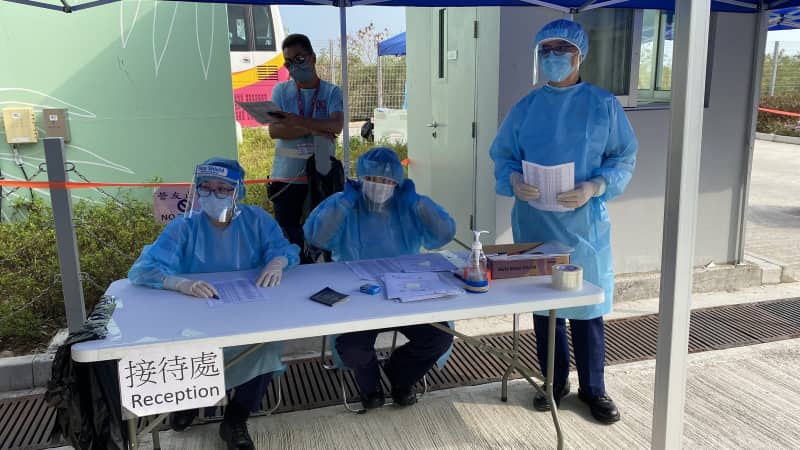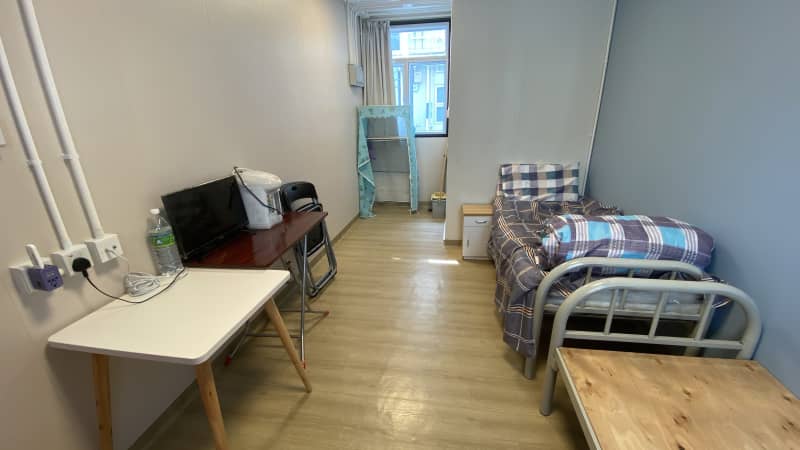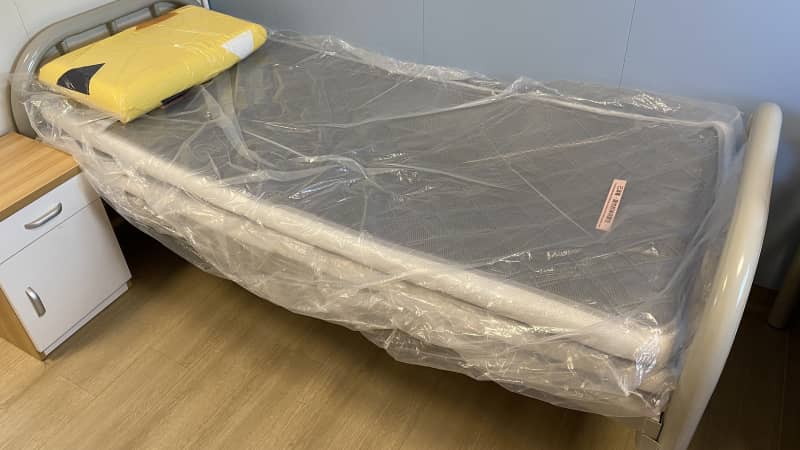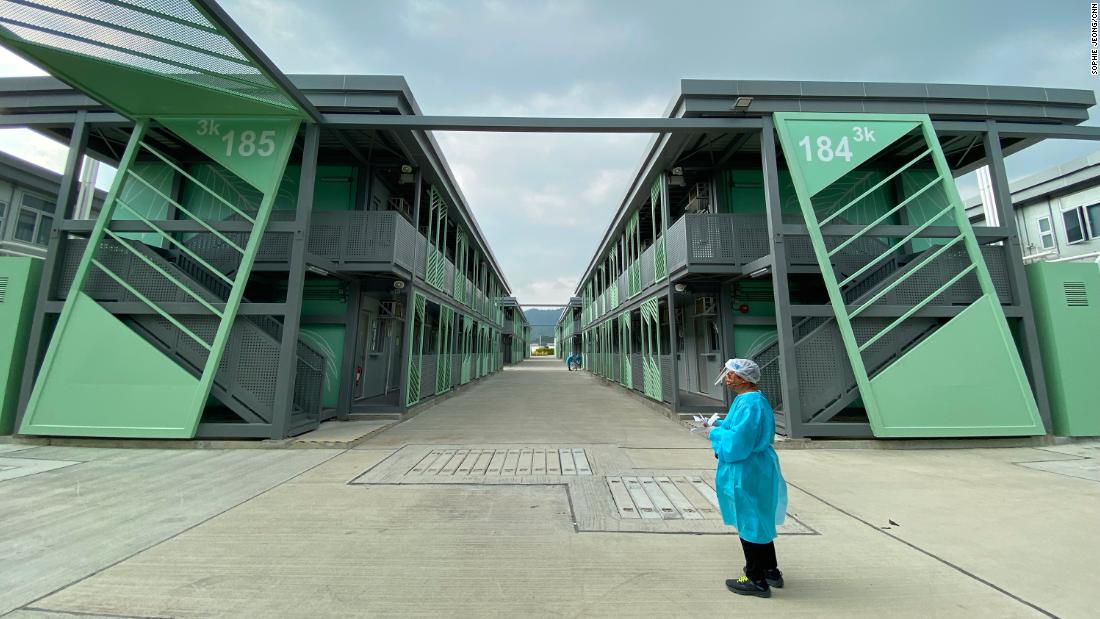The veterans suggested tips like downloading my favorite Netflix shows and bringing items like a WiFi hotspot, an extension cord, loads of food, slippers and booze.
The first day
I landed at Hong Kong International Airport on January 2.
After deplaning, I had to present a QR code obtained after filling out a health declaration form, verify my phone number, obtain a quarantine order and get a nose and throat swab.

Travelers wait for Covid-19 test results at Hong Kong International Airport.
Sophie Jeong/CNN
Then I was directed to an area where I waited three-and-a-half hours for my test result before I could pick up my luggage and get into a van that took me and five other passengers to Penny’s Bay.
On our way there, the van drove through the entrance of Hong Kong Disneyland, which the quarantine center is ironically located next to.
After driving through a set of green gates, the van passed rows of colorful two-story buildings that looked like stacked shipping containers before dropping us off at the reception desk. Staff wearing blue disposable caps and gowns, face shields, masks and gloves — who are called the “Blue Meanies” by some inmates — assigned me to a unit.

Workers dressed in full protective gear sit behind a reception desk at Penny’s Bay.
Sophie Jeong/CNN
Life in government quarantine camp
My room at the camp reminded me of my old college dorm room. It came with two single beds with thin mattresses, a hard sponge pillow and a duvet, two small tables with a small television, an electric kettle, a hair dryer, two folding plastic chairs, a fabric closet, a bedside table, an air conditioner and a water heater.
I was allowed to open my window to retrieve food and other necessities that were delivered, or just to get some fresh air. Three meals were provided daily in plastic bags (in the morning, afternoon and evening) and were left on a tray outside my window for me to collect. Through that same window, staff members swabbed my nose and throat as part of the daily Covid-19 testing requirements.
As of 9 a.m. local time on January 4, when I was on my third day there, almost 1,300 people were occupying 995 units at the camp, according to the CHP.

My room at the quarantine camp reminded me of my old college dorm.
Sophie Jeong/CNN
When I checked in, I was given a menu with four meal options: Chinese, Western, vegetarian and soft foods. I chose Chinese for most of my meals, but the instruction on the menu warned that I will only start getting my chosen meals two days after submitting my selections. To my surprise, though, the selections began arriving almost immediately.
That said, they were like bland airplane meals, and I was stuck with them as food delivery companies like Deliveroo or Foodpanda don’t service the camp. Staff also delivered water bottles, trash bags and fruits to my room. In case I needed more of the camp-provided items like instant noodles or towels, I was given a quarantine center hotline number to call and a number to text on WhatsApp, but these items did take time to be delivered.

A staff member delivers meals in plastic bags to people who are in quarantine at the camp.
Sophie Jeong/CNN
It was possible to get items dropped off by family or friends, but it wasn’t easy. In order to get care packages, the deliverer had to apply for approval either 24 hours in advance with a full list and photos of items, or they had to fill out a form upon arrival. Items like alcohol and cigarettes were prohibited.
The room also got quite noisy when staff delivered meals and other essentials to my neighbors, workers wheeled carts and dumpsters outside, trucks drove by the buildings and airplanes flew over.
My mattress was very thin, so I placed the one from the other bed on top of it. They were covered with plastic wraps and made a sound whenever I moved. My feet also touched the bed frame when I slept — and considering I’m only 5 feet 5 inches (165 centimeters), I can’t imagine what it was like for taller people.

Mattresses provided at the camp were very thin and covered with plastic wraps.
Sophie Jeong/CNN
On my last day there, health workers came by in the morning to test me for Covid. After getting swabbed, I had to wait in the room until the Health Department informed the camp that I was cleared to be transferred to the hotel I booked. Then I had to wait again until a worker came by to tell me I could come out of my room, check out and get in line for my assigned van. Staff helped me load my luggage to the van, which took me to my hotel for another 17 days of quarantine.
Final reflections
As crazy as it sounds, by some metrics I felt lucky.
The price of getting in was high. From the cost of my quarantine hotel and the lost rent for my apartment, to excess baggage fees to bring necessary items for quarantine, these expenses quickly added up.
And it’s not only about the money.
The time I lost from being confined and the toll on my physical and mental health and my social life are immeasurable. Moreover, the price isn’t going down any time soon, and I’m not sure how many more times I can afford it.
